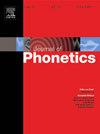词级结构对夏威夷语口语停顿实现的影响
IF 2.4
1区 文学
0 LANGUAGE & LINGUISTICS
引用次数: 0
摘要
夏威夷语,或称 "Ōlelo Hawaiʻi",是一种在夏威夷群岛上使用的东波利尼西亚语。本研究考察了 1970-80 年代广播节目《Ka Leo Hawaiʻi》中的夏威夷语口语停顿,首先确定这一代夏威夷语使用者的无声停顿是有吸气的还是无吸气的,其次确定单词层面的前音结构是否会影响语音起始时间(VOT)或闭合持续时间的实施,或停顿变长的频率。夏威夷语只有两个主要的口语停顿/p k/([t]在这些说话者的方言中是一个罕见的变体),结果表明/p/和/k/对这些说话者来说是不吸气的。通过对每个停顿词的词性词位(初始词位、中间词位)、前置词位(初始词位、中间词位)以及它是在主要重读音节、次要重读音节还是在非重读音节中进行编码,考察了前置词的影响。结果表明,与词性位置不同,前置词初始位置的条件是较长的 VOT、闭合持续时间和较少的连读。此外,还存在交互作用,表明在非重音和次重音音节中,词的初始位置会导致更长的 VOT,而在主重音音节中则不会。这些结果与夏威夷语的拟声和语音战术结构有关,夏威夷语的拟声和语音战术结构可能依赖于声学线索来区分拟声结构和词项的分段。本文章由计算机程序翻译,如有差异,请以英文原文为准。
Effects of word-level structure on oral stop realization in Hawaiian
Hawaiian, or ‘Ōlelo Hawaiʻi, is an Eastern Polynesian language spoken on the islands of Hawaiʻi. This study examines oral stops in Hawaiian as produced by speakers on the 1970–80s radio program Ka Leo Hawaiʻi, first, to establish whether the voiceless stops of this generation of Hawaiian speakers were aspirated or unaspirated, and second, to determine whether word-level prosodic structure has an effect on either the implementation of voice onset time (VOT) or closure duration, or how often stops are lenited. Hawaiian has only two primary oral stops /p k/ ([t] is a rare variant in these speakers’ dialects), and the results indicate that /p/ and /k/ are unaspirated for these speakers. Prosodic influences are examined by coding each stop for lexical word position (initial, medial), prosodic word position (initial, medial) and whether it is in a primary stressed, secondary stressed, or unstressed syllable. Results indicate that prosodic word initial position conditions both longer VOT, closure duration, and fewer lenited productions, separately from lexical word position. Moreover, there is an interaction indicating that word initial position leads to longer VOT in unstressed and secondarily stressed syllables, but not in syllables with primary stress. These results are discussed with respect to the prosodic and phonotactic structure of Hawaiian, which may rely on acoustic cues for the disambiguation of prosodic structure and segmentation of lexical items.
求助全文
通过发布文献求助,成功后即可免费获取论文全文。
去求助
来源期刊

Journal of Phonetics
Multiple-
CiteScore
3.50
自引率
26.30%
发文量
49
期刊介绍:
The Journal of Phonetics publishes papers of an experimental or theoretical nature that deal with phonetic aspects of language and linguistic communication processes. Papers dealing with technological and/or pathological topics, or papers of an interdisciplinary nature are also suitable, provided that linguistic-phonetic principles underlie the work reported. Regular articles, review articles, and letters to the editor are published. Themed issues are also published, devoted entirely to a specific subject of interest within the field of phonetics.
 求助内容:
求助内容: 应助结果提醒方式:
应助结果提醒方式:


